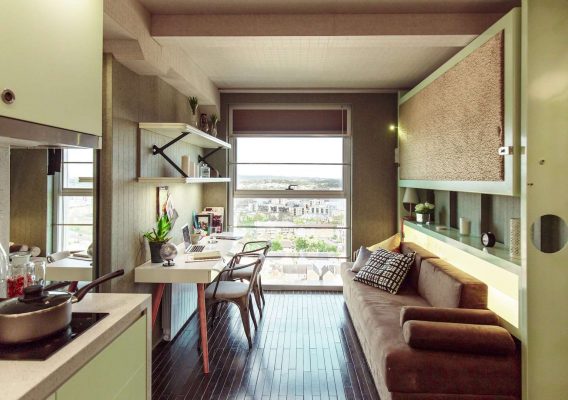Co-Living: An Alternative Hong Kong Housing Solution for Youth?
Youth I.D.E.A.S. 44
Society and Livelihood
Co-Living: An Alternative Hong Kong Housing Solution for Youth?
21 August, 2019
 Co-living is a modern form of shared housing that combines private living spaces with shared communal facilities. It provides an affordable housing alternative by sharing expenses. The idea of co-living also emphasizes building up interpersonal networks and promoting social contact through community events.
Co-living is a modern form of shared housing that combines private living spaces with shared communal facilities. It provides an affordable housing alternative by sharing expenses. The idea of co-living also emphasizes building up interpersonal networks and promoting social contact through community events.
The earlier form of co-living originated from Denmark’s co-housing projects in the 1970s. This extended gradually to The Netherlands and onto the UK. In recent years, it can be seen throughout the US, across Europe, Japan, Taiwan, South Korea and other places in Asia. Co-living is not necessarily treated as a long-term solution for youth housing problems in those places. However, they might opt for co-living due to its affordability, lifestyle options and building up interpersonal networks.
Soaring property prices and high rentals has made Hong Kong the world’s least affordable housing market for nine years in succession. According to Demographia, Hong Kong’s median property price in 2018 was 20.9 times more than the median household income. Apart from the private market, the public housing supply barely meets young people’s demand (of the 120,000 public rental-housing applicants in the Quota and Points System, 52% were under the age of 30). In addition, 67% of the applicants among the 55,000 White Form and One-person applicants in 2017 were under the age of 30. However, only 50 applicants were allocated flats.
With both the traditional private and public housing market not meeting their housing needs, more young people are opting for co-living (operated by NGOs or the private sector). In its 2011-2012 Policy Address, the government also proposed a Youth Hostel Scheme similar to co-living. In this scheme, the government would support NGOs to build more (and more affordable) places for young people. The initial estimate is that the 6 Hostels being proposed would provide 2,856 hostel units in Hong Kong.
In order to investigate young people’s views on co-living, this research was conducted between May and July 2019 and data was collected for analysis through a survey of: 520 young people (aged 18-30); 20 young people participating in case interviews; and interviews with eight experts or co-living operators.
This research also references the experiences of other places in developing co-living. The difficulties in developing co-living spaces in Hong Kong were also investigated in this study. Possible solutions will be highlighted that, it is hoped, would be helpful for the long-run development of co-living and providing a way out of the housing problems in Hong Kong.
Discussion
- Since the public and private housing markets barely meet the demand of young people, the government should adopt multi-pronged measures to widen the range of alternatives in order to solve problems of youth housing.
- Developing co-living in Hong Kong could provide an affordable housing alternative for young people. It could also relieve the pressure on youth-housing problems by offering living spaces in a relatively short period while optimising the use of land.
- The youth recognized the value of co-living in the interviews, while lack of privacy and space allocation were their main concerns.
- There are multi-dimensional difficulties in developing co-living in Hong Kong.4.1There is a lack of suitable buildings.
4.2 Lack of awareness regarding co-living4.3 Strict legal regulation in building renovation
4.4 Difficulty of encouraging communication
- The government should consider having a pilot youth co-living scheme. After that, co-living could be taken forward to other age groups.
Recommendations
- The government should address young peoples’ housing needs by adopting multi-pronged measures to widen the range of housing options.
- Implement a co-living pilot scheme by optimising different vacant property.2.1Renovating the Housing Authority’s flatted factory estates.2.2
Developing co-living through assisting and encouraging enterprises to perform their social responsibility.2.3 Optimising the use of land, by repurposing vacant school premises.
- Promoting the concept of “community and collaboration” in co-living.




